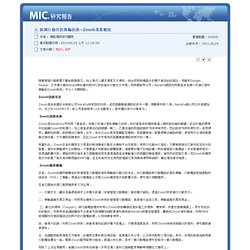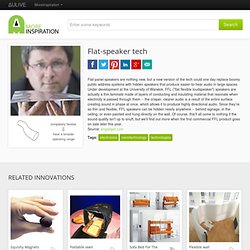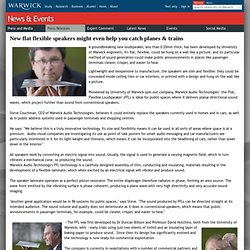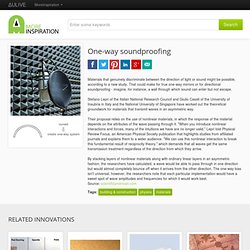

株式会社 村田制作所. 2007 CARTS - Reduced Microphonics and Sound Emissions.pdf (application/pdf 物件) Examples of Noise Countermeasures (Video) The replacement evaluation of low acoustic noise capacitors is demonstrated. The acoustic noise phenomenon occurs in some cases due to the piezoelectric properties of ceramic. In order to solve this, Murata has developed a low acoustic noise capacitor! Click here to experience the effectiveness of the low acoustic noise capacitors of Murata. Outline Along with the noise reduction of electronic devices, the "acoustic noise" caused by the vibration of capacitors, which was not conventionally noticeable, has become a design issue in the power circuits of various applications, such as laptop computers, mobile phones, DSC, etc.
Reduce acoustic noise from capacitors : EDN Europe. Radiation Pattern—Spread it Around. Www.judicaelcornu.com. 新興行動付款傳輸技術. 隨著智慧行動裝置不斷創新與普及,加上現代人講求速度及方便性,結合短程射頻晶片的電子產品紛紛竄出,相繼有Google、Paypal、及手機大廠如Nokia等計畫利用NFC技術搶攻行動支付市場。

而美國新秀公司—Naratte開發利用超音波為媒介來進行資料傳輸的Zoosh技術,亦令人引頸期盼。 Zoosh發展背景 Zoosh是由美國矽谷新創公司Naratte所研發的科技,是短距離無線通訊的其中一種,相關專利有八項。 Naratte總公司位於美國加州,成立於2009年5月。 該公司草創時有12名在職員工,資本額約為500萬美元。 Zoosh發展技術 Zoosh是Naratte公司利用「超音波」為媒介來進行資料傳輸之技術。 有鑑於此,Zoosh目前的應用主力更是針對消費者行動支付機制平台來研發,使用方式與NFC相似,只要稍微接近已做好設定的付款裝置,資料的傳輸便可立刻開始。 Zoosh應用範圍 目前,Zoosh的應用範疇係針對智慧型行動電話資料傳輸與行動付款為主,如行動電話對行動電話的資料傳輸、行動電話對銷售點終端系統(POS)之傳輸。 目前已開始支援之實際應用有下列五項: 一、行動支付:顧名思義便是將手上的電子設備(如智慧型行動電話)變成電子錢包,透過Zoosh技術進行行動支付。 二、傳輸虛擬支票及現金:利用兩台擁有Zoosh技術的智慧型行動電話,直接進行金流交易,傳輸虛擬支票或現金。 三、數位折價券(Coupon):將行動電話裡所存有以Zoosh技術轉換成資料檔之折價券、禮券等,放置於感應機器上,即可完成折扣的動作。 Flat-speaker tech. Flat-panel speakers are nothing new, but a new version of the tech could one day replace boomy public address systems with hidden speakers that produce easier-to-hear audio in large spaces.

Under development at the University of Warwick, FFL ("flat flexible loudspeaker") speakers are actually a thin laminate made of layers of conducting and insulating material that resonate when electricity is passed through them -- the crisper, clearer audio is a result of the entire surface creating sound in phase at once, which allows it to produce highly directional audio. Since they're so thin and flexible, FFL speakers can be hidden nearly anywhere -- behind signage, in the ceiling, or even painted and hung directly on the wall. Of course, this'll all come to nothing if the sound quality isn't up to snuff, but we'll find out more when the first commercial FFL product goes on sale later this year.
Source: engadget.com. New flat flexible speakers might even help you catch planes & trains. A groundbreaking new loudspeaker, less than 0.25mm thick, has been developed by University of Warwick engineers, it's flat, flexible, could be hung on a wall like a picture, and its particular method of sound generation could make public announcements in places like passenger terminals clearer, crisper, and easier to hear.

Lightweight and inexpensive to manufacture, the speakers are slim and flexible: they could be concealed inside ceiling tiles or car interiors, or printed with a design and hung on the wall like a picture. Pioneered by University of Warwick spin-out company, Warwick Audio Technologies' the 'Flat, Flexible Loudspeaker' (FFL) is ideal for public spaces where it delivers planar directional sound waves, which project further than sound from conventional speakers. He says: "We believe this is a truly innovative technology. Its size and flexibility means it can be used in all sorts of areas where space is at a premium. For further information, please contact: Deep Bleeder Acoustic Coagulation. One-way soundproofing. Materials that genuinely discriminate between the direction of light or sound might be possible, according to a new study.

That could make for true one-way mirrors or for directional soundproofing - imagine, for instance, a wall through which sound can enter but not escape. Stefano Lepri of the Italian National Research Council and Giulio Casati of the University of Insubria in Italy and the National University of Singapore have worked out the theoretical groundwork for materials that transmit waves in an asymmetric way. Their proposal relies on the use of nonlinear materials, in which the response of the material depends on the attributes of the wave passing through it. "When you introduce nonlinear interactions and forces, many of the intuitions we have are no longer valid," Lepri told Physical Review Focus, an American Physical Society publication that highlights studies from affiliated journals and explains them to a wider audience.
Source: scientificamerican.com. Bone conduction mobile phone. The Doppler Effect and Shock Waves. The Doppler effect is a phenomenon observed whenever the source of waves is moving with respect to an observer.

The Doppler effect can be described as the effect produced by a moving source of waves in which there is an apparent upward shift in frequency for the observer and the source are approaching and an apparent downward shift in frequency when the observer and the source is receding. The Doppler effect can be observed to occur with all types of waves - most notably water waves, sound waves, and light waves. Sound from ultrasound. Parametric array[edit] Since the early 1960s, researchers have been experimenting with creating directive low-frequency sound from nonlinear interaction of an aimed beam of ultrasound waves produced by a parametric array using heterodyning. Ultrasound has much shorter wavelengths than audible sound, so that it propagates in a much narrower beam than any normal loudspeaker system using audio frequencies.
The first modern device was created in 1998,[1] and is now known by the trademark name "Audio Spotlight", a term first coined in 1983 by the Japanese researchers[2] who abandoned the technology as infeasible in the mid-1980s. A transducer can be made to project a narrow beam of modulated ultrasound that is powerful enough, at 100 to 110 dBSPL, to substantially change the speed of sound in the air that it passes through.
There are some limitations with this approach. Applications[edit] Military[edit] Audio Spotlight - Add sound and preserve the quiet. Fundamental Limitations of Loudspeaker Directivity By Dr. F. Joseph Pompei Mathematical Proof: Julian Treasure: 5 ways to listen better.